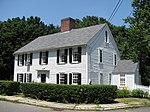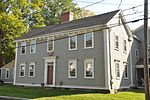Wade House (Ipswich, Massachusetts)

The Wade House is a historic house in Ipswich, Massachusetts. The 1+1⁄2-story gambrel-roofed central chimney house was built in 1792 by Francis Merrifield, Jr. It was acquired in 1827 by Mary Wade, daughter of local Revolutionary War soldier Nathaniel Wade. It has been in the Wade family since then. The house originally had two rooms downstairs and two upstairs; the rear of the house was added in two stages. A number of period details survive, including the central staircase and paneled doors. Fragments of period wallpaper have also been preserved, and reproduction wallpaper has been used in one of the downstairs rooms.The house was added to the National Register of Historic Places in 1980.
Excerpt from the Wikipedia article Wade House (Ipswich, Massachusetts) (License: CC BY-SA 3.0, Authors, Images).Wade House (Ipswich, Massachusetts)
Woods Lane,
Geographical coordinates (GPS) Address Nearby Places Show on map
Geographical coordinates (GPS)
| Latitude | Longitude |
|---|---|
| N 42.676888888889 ° | E -70.831388888889 ° |
Address
Woods Lane 10
01938
Massachusetts, United States
Open on Google Maps










